Preparing for Accidents and Emergencies
Such as a sudden illness or injury
1 Calling an Ambulance
You do not need to insert coins to make an emergency call from a pay phone.
Pick up the receiver and push the emergency button to call.
If you require urgent care, for example due to a sudden illness, injury from a traffic accident or other incident, burns, or poisoning, dial 119 and calmly communicate information such as your location, name, and phone number.
| There’s a fire! かじです(火事です) |
Kajidesu! |
| Please send an ambulance. きゅうきゅうしゃです(救急車です) |
Kyukyusha desu. |
| My address is *****. じゅうしょは(住所は)**(区)**ちょう(町)*ちょうめ(丁目)*ばん(番)*ごうです(号です)。 |
Jusho wa **Ku, **cho, *chome, *ban, *go desu. |
| My name is *****. わたしのなまえ(名前)は *****です。 |
Watashi no namae wa ***** desu. |
| My telephone number is ***** . でんわばんごう(電話番号)は *****です。 |
Denwa bango wa ***** desu. |
The Fire Department has contracted a private interpretation agency to provide interpretation services over the phone in English, Chinese, Korean, Portuguese, and Spanish. In the event of an emergency or disaster, this service will facilitate responses to 119 calls made by those who may not communicate well in Japanese—for example, foreign tourists or international students in Osaka.
Contacting emergency services by FAX119 or NET119
Fax: 119 or 06-6538-0119 (A fax form is available.)
The caller is responsible for communication fees required for calling 06-6538-0119.
To use <NET119> , you need to register with your smartphone or mobile phone beforehand.
*For more information on FAX119 and NET119, please refer to the website of Osaka Municipal Fire Department.
When contacting emergency services by fax, e-mail, or NET119, you need to write information including:
- Location of occurrence
- Current situation (where it hurts, etc.)
- Your name
- Patient’s age and gender
- Fax No. (if using FAX119)
| Names of fire stations | Telephone Facsimile |
Locations of fire stations |
|---|---|---|
| Kita | TEL:06-6372-0119 FAX:06-6372-4885 | 19-41 Chayamachi Kita-Ku(Osaka Metro Nakatsu, Hankyu Osaka-Umeda) |
| Miyakojima | TEL:06-6923-0119 FAX:06-6923-6444 | 2-1-8 Miyakajima Hon-dori Miyakojima-Ku(Osaka Metro Miyakojima, JR Sakuranomiya) |
| Fukushima | TEL:06-6465-0119 FAX:06-6465-6311 | 3-17-22 Yoshino Fukushima-Ku(Osaka Metro Noda Hanshin, Hanshin Noda, JR Ebie) |
| Konohana | TEL:06-6461-0119 FAX:06-6461-5572 | 1-8-30 Kasugade-Kita Konohana-Ku(Hanshin Chidoribashi, JR Nishikujo) |
| Chuo | TEL:06-6947-0119 FAX:06-6942-5745 | 2-1-6 Uchihonmachi Chuo-Ku(Osaka Metro Tanimachi 4-chome, Osaka Metro Sakaisuji Hommachi) |
| Nishi | TEL:06-4393-0119 FAX:06-4393-0124 | 1-12-54 Kujo-Minami Nishi-Ku(Osaka Metro Dome-mae Chiyozaki, JR Taisho) |
| Minato | TEL:06-6573-0119 FAX:06-6573-0325 | 1-4-1 Benten Minato-Ku(Osaka Metro/JR Bentencho) |
| Taisho | TEL:06-6552-0119 FAX:06-6552-4099 | 3-5-16 Kobayashi-Higashi Taisho-Ku(Osaka City Bus Kobayashi) |
| Tennoji | TEL:06-6771-0119 FAX:06-6771-3293 | 8-5-10 Uehonmachi Tennoji-Ku(Osaka Metro Tanimachi 9-chome, Osaka Metro Shitennoji-mae Yuhigaoka) |
| Naniwa | TEL:06-6641-0119 FAX:06-6634-0119 | 1-14-20 Motomachi Naniwa-Ku(Osaka Metro Namba, JR Namba) |
| Nishi-Yodogawa | TEL:06-6472-0119 FAX:06-6472-0533 | 1-10-20 Mitejima Nishi-Yodogawa-Ku(JR Mitejima) |
| Yodogawa | TEL:06-6308-0119 FAX:06-6308-4071 | 4-10-12 Kikawa-Higashi Yodogawa-Ku(Osaka Metro Nishinakajima-Minamigata, Hankyu Minamikata) |
| Higashi-Yodogawa | TEL:06-6320-0119 FAX:06-6320-1984 | 4-4-27 Sugahara Higashi-Yodogawa-Ku(Hankyu Kamishinjo, Hankyu Awaji, JR Awaji) |
| Higashinari | TEL:06-6971-0119 FAX:06-6971-9412 | 1-27-13 Oimazato-Nishi Higashinari-Ku(Osaka Metro Imazato) |
| Ikuno | TEL:06-6731-0119 FAX:06-6731-7044 | 1-13-8 Sharizi Ikuno-Ku(Osaka City Bus Ikunoshobosho-mae, Osaka City Bus Oikebashi) |
| Asahi | TEL:06-6952-0119 FAX:06-6952-0125 | 1-1-11 Omiya Asahi-Ku(Osaka Metro Sembayashi-Omiya, Keihan Morishoji) |
| Joto | TEL:06-6931-0119 FAX:06-6931-0072 | 3-4-20 Chuo Joto-Ku(Osaka Metro Gamo 4-chome) |
| Tsurumi | TEL:06-6912-0119 FAX:06-6912-6043 | 5-5-45 Yokotsutsumi Tsurumi-Ku(Osaka Metro Yokozutsumi) |
| Abeno | TEL:06-6628-0119 FAX:06-6628-0925 | 4-4-30 Matuzaki-Cho Abeno-Ku(Osaka Metro Fuminosato, Osaka Metro Abeno, JR Tennoji) |
| Suminoe | TEL:06-6685-0119 FAX:06-6685-8120 | 4-11-6 Misaki Suminoe-Ku(Osaka Metro Suminoekoen) |
| Sumiyoshi | TEL:06-6695-0119 FAX:06-6695-4001 | 1-1-9 Oriono Sumiyoshi-Ku(Nankai Abikomae, JR Abikocho) |
| Higashi-Sumiyoshi | TEL:06-6691-0119 FAX:06-6691-1444 | 3-4-5 Minami-Tanabe Higashi-Sumiyoshi-Ku(Osaka Metro Komagawa-Nakano, Osaka Metro Nishitanabe) |
| Hirano | TEL:06-6790-0119 FAX:06-6790-8101 | 1-2-9 Hirano-Minami Hirano-Ku(Osaka Metro Hirano) |
| Nishinari | TEL:06-6653-0119 FAX:06-6653-2119 | 1-4-26 Kishinosato Nishinari-Ku(Osaka Metro Kishinosato, Osaka Metro Tengachaya) |
| Suijo | TEL:06-6574-0119 FAX:06-6574-0140 | 3-1-47 Chikko Minato-Ku(Osaka Metro Osakako) |
2 Emergencies at night and out of business hours
Sudden illnesses on Sundays, holidays, Year-end/New Year holidays and during the night are handled at emergency clinics.
Please be sure to bring your National Health Insurance Certificate when you see a doctor.
| Internal medicine/Pediatrics | Weekday | 22:00 - 5:30 |
|---|---|---|
| Saturday (except National & Year-end/New Year holidays) | 15:00 - 5:30 | |
| Sunday, National & Year-end/New Year holidays (Dec. 30th - Jan. 4th) | 17:00 - 5:30 | |
| Ophthalmology/Otolaryngology | Weekday | 22:00 - 0:30 |
| Saturday (except National & Year-end/New Year holidays) | 15:00 - 21:30 | |
| Sunday, National & Year-end/New Year holidays (Dec. 30th - Jan. 4th) | 10:00 - 21:30 |
| Internal medicine/Pediatrics | Sunday, National & Year-end/New Year holidays (Dec. 30th - Jan. 4th) | 10:00 - 16:30 |
|---|---|---|
| Miyakojima After-hours Emergency Clinic | 1-24-23 Miyakojima-Minami-dori, Miyakojima-ku | (TEL)06-6928-3333 |
| Nishi-Kujo After-hours Emergency Clinic | 5-4-25 Nishi-Kujo, Konohana-ku | (TEL)06-6464-2111 |
| Juso After-hours Emergency Clinic | 1-11-26 Juso-Higashi, Yodogawa-ku | (TEL)06-6304-7883 |
| Imazato After-hours Emergency Clinic | 3-6-6 Oimazato-Nishi, Higashinari-ku | (TEL)06-6972-0767 |
| Sawano-cho After-hours Emergency Clinic | 4-14-28 Minamisumiyoshi, Sumiyoshi-ku | (TEL)06−4700-7771 |
| Nakano After-hours Emergency Clinic | 2-1-20 Nakano, Higashi-Sumiyoshi-ku | (TEL)06-6705-1612 |
※Nakano After-hours Emergency Clinic also provides medical service only for Pediatrics on weekday nights (20:30- 23:00).
3 Emergency Clinics
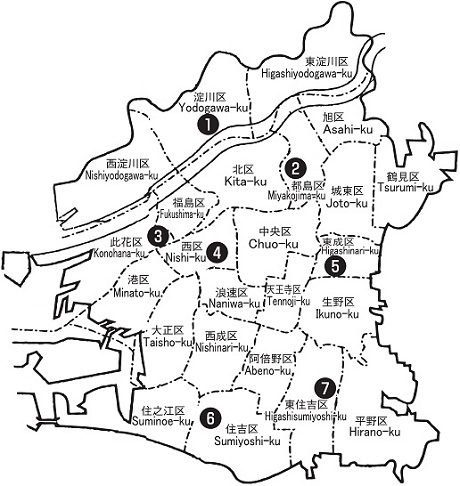
| ❶Juso After-hours Emergency Clinic |
|---|
| 1-11-26 Juso-Higashi,Yodogawa-ku |
| (TEL) 06-6304-7883 |
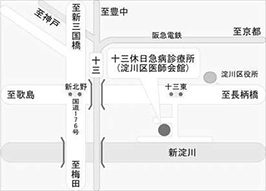 |
| ❷Miyakojima After-hours Emergency Clinic |
|---|
| 1-24-23 Miyakojima-Minami-dori,Miyakojima-ku |
| (TEL) 06-6928-3333 |
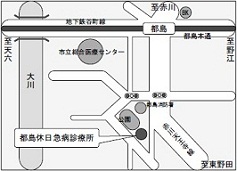 |
| ❸Nishi-Kujo After-hours Emergency Clinic |
|---|
| 5-4-25 Nishi-Kujo, Konohana-ku |
| (TEL) 06-6464-2111 |
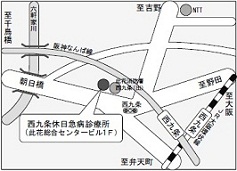 |
| ❹Chuo Emergency Clinic |
|---|
| 4-10-13 Shimmachi, Nishi-ku |
| (TEL) 06-6534-0321 |
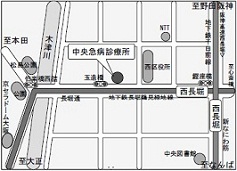 |
| ❺Imazato After-hours Emergency Clinic |
|---|
| 3-6-6 Oimazato-Nishi, Higashinari-ku |
| (TEL) 06-6972-0767 |
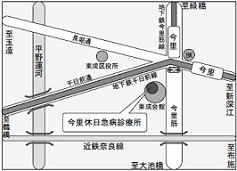 |
| ❻Sawano-cho After-hours Emergency Clinic |
|---|
| 4-14-28 Minamisumiyoshi, Sumiyoshi-ku |
| (TEL) 06−4700-7771 |
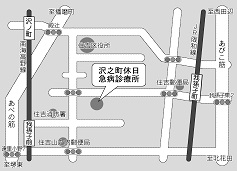 |
| ❼Nakano After-hours Emergency Clinic |
|---|
| 2-1-20 Nakano,Higashi-Sumiyoshi-ku |
| (TEL) 06-6705-1612 |
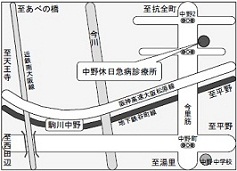 |
4 Information Service for Emergency Hospitals & Clinics
The following telephone numbers provide information of hospitals and clinics. (24 hours / Open 365 days)
Osaka Prefectural Emergency Medical Information Center
(TEL)06-6693-1199
Emergency Anshin Center Osaka
(TEL)#7119 or (TEL)06−6582−7119
Fire
If a fire breaks out
*You do not need to insert coins to make an emergency call from a pay phone. Pick up the receiver and push the emergency button to call.
*In the event of an emergency such as a fire or traffic accident, dial 119 and calmly communicate information such as your location, name, and phone number.
| There’s a fire! かじです(火事です) |
Kajidesu! |
| My address is *****. じゅうしょは(住所は)**(区)**ちょう(町)*ちょうめ(丁目)*ばん(番)*ごうです(号です)。 |
Jusho wa **Ku, **cho, *chome, *ban, *go desu. |
| My name is *****. わたしのなまえ(名前)は *****です。 |
Watashi no namae wa ***** desu. |
| My telephone number is ***** . でんわばんごう(電話番号)は *****です。 |
Denwa bango wa ***** desu. |
The Fire Department has contracted a private interpretation agency to provide interpretation services over the phone in English, Chinese, Korean, Portuguese, and Spanish. In the event of an emergency or disaster, this service will facilitate responses to 119 calls made by those who may not communicate well in Japanese—for example, foreign tourists or international students in Osaka.
Contacting emergency services by FAX119 or NET119
Fax: 119 or 06-6538-0119 (A fax form is available.)
The caller is responsible for communication fees required for calling 06-6538-0119.
To use <NET119> , you need to register with your smartphone or mobile phone beforehand.
*For more information on FAX119 and NET119, please refer to the website of Osaka Municipal Fire Department.
When contacting emergency services by fax, e-mail or NET119, you need to write information including:
- Location of occurrence
- Current situation (what is burning, etc.)
- Your name
- Fax No. (if using FAX119)
Police
* You do not need to insert coins to make an emergency call from a pay phone. Pick up the receiver and push the emergency button to call.
| I’ve been robbed. どろぼう(泥棒です)。 |
Dorobou desu. |
| There’s been a traffic accident. こうつうじこです(交通事故です) |
Kotsu jiko desu. |
| Someone is injured. けがをしています(怪我をしています) |
Kega o shite imasu. |
| Help me! たすけてください(助けてください)。 |
Tasukete kudasai. |
| The place is *****. ばしょは(場所は) *****です。 |
Basho wa ***** desu. |
| My address is *****. じゅうしょは(住所は)**(区)**ちょう(町)*ちょうめ(丁目)*ばん(番)*ごうです(号です)。 |
Jusho wa ** Ku, ** cho, * chome, * ban, * go desu. |
| My name is *****. なまえは(名前は)*****です。 |
Namae wa ***** desu. |
| My telephone number is *****. でんわばんごう(電話番号)は *****です。 |
Denwa bango wa ***** desu. |
1 Traffic Accidents
When a traffic accident occurs, you should give aid to the injured first. If an ambulance is needed, call 119. Then be sure to call the Police at 110 and calmly report the incident, its details, where you are, and landmarks, etc.
2 Robbery etc.
If you fall victim to a crime such as robbery or theft, call the Police at 110 and calmly report where the crime happened, your name and phone number etc. It is important to make yourself aware of the location of your local Police station or Police box.
Report by a fax or e-mail
(Listings)The contents of the accident, your address, name, fax number
m110@police.pref.osaka.jp
(Listings)The contents, sender’s name and address (where a sender is)
Police Stations
| Names of police stations |
TEL / Locations |
|---|---|
| Oyodo | TEL 06-6376-1234 1-5-25 Nakatsu, Kita-ku, (Subway Nakatsu sta.) |
| Sonezaki | TEL 06-6315-1234 2-16-14 Sonezaki, Kita-ku, (Subway/Hanshin Umeda, Hankyu Osaka-Umeda, JR Osaka) |
| Temma | TEL 06-6363-1234 1-12-12 Nishi-Temma, Kita-ku,(Subway/Keihan Yodoyabashi and Kitahama, Keihan Naniwabashi) |
| Miyakojima | TEL 06-6925-1234 1-7-1 Miyakojima Kita-dori, Miyakojima-ku, (Subway Miyakojima sta.) |
| Fukushima | TEL 06-6465-1234 4-9-19 Yoshino, Fukushima-ku, (Subway Nodahanshin sta., JR/Hanshin Noda, JR Ebie) |
| Konohana | TEL 06-6466-1234 1-3-1 Kasugade-Kita, Konohana-ku, (Osaka City Bus Kasugade, JR Nishikujo Sta.) |
| Higashi | TEL 06-6268-1234 1-3-18 Hommachi, Chuo-ku, (Subway Sakaisuji-Hommachi sta., Osaka City Bus Honmachi 1 Chome) |
| Minami | TEL 06-6281-1234 1-5-26 Higashi-Shinsaibashi, Chuo-ku, (Subway Nagahoribashi sta.) |
| Nishi | TEL 06-6583-1234 2-6-3 Kawaguchi, Nishi-ku, (Subway Awaza sta., Osaka City Bus Kawaguchi 1 Chome) |
| Minato | TEL 06-6574-1234 1-6-22 Ichioka, Minato-ku, (Subway/JR Bentencho sta.) |
| Taisho | TEL 06-6555-1234 3-4-21 Kobayashi-Higashi, Taisho-ku, (City bus Kobayashi sta. (Taisho Police Station)) |
| Tennoji | TEL 06-6773-1234 5-8 Rokumantai-cho, Tennoji-ku, (Subway Shitennojimae Yuhigaoka sta.) |
| Naniwa | TEL 06-6633-1234 5-5-11 Nipponbashi, Naniwa-ku, (Subway Ebisu-cho sta., JR Shin-Imamiya, Nankai Shin-Imamiya, Nankai Imamiya Ebisu, Hankai Ebisucho) |
| Nishiyodogawa | TEL 06-6474-1234 2-6-24 Chibune, Nishiyodogawa-ku, (JR Mitejima sta., Hanshin Bus Mitejima) |
| Yodogawa | TEL 06-6305-1234 3-7-27 Juso-Hommachi, Yodogawa-ku, (Hankyu Juso sta.) |
| Higashiyodogawa | TEL 06-6325-1234 1-6-18 Hoshin, Higashiyodogawa-ku, (Hankyu Kamishinjo sta.) |
| Higashinari | TEL 06-6974-1234 1-25-15 Oimazato-Nishi, Higashinari-ku, (Subway Imazato sta., Osaka City Bus Imazato) |
| Ikuno | TEL 06-6712-1234 3-14-12 Katsuyama-Kita, Ikuno-ku, (City bus Ikuno Kuyakusho-mae sta.) |
| Asahi | TEL 06-6952-1234 1-4-1 Nakamiya, Asahi-ku, (City bus Asahi Keisatsusho sta., JR Shirokitakoendori) |
| Joto | TEL 06-6934-1234 1-9-41 Chuo, Joto-ku, (Subway Gamo Yon-chome sta., Osaka City Bus Chikatetsu Gamo 4 Chome) |
| Tsurumi | TEL 06-6913-1234 6-1-1 Moroguchi, Tsurumi-ku, (Subway Yokozutsumi sta., Osaka City Bus/Kintetsu Bus Tsurumi-kuyakusho-mae) |
| Abeno | TEL 06-6653-1234 5-13-5 Abenosuji, Abeno-ku, (Subway Abeno sta., Hankai Matsumushi, Osaka City Bus Abenosuji 5 Chome) |
| Suminoe | TEL 06-6682-1234 3-1-57 Shin-Kitajima, Suminoe-ku, (Subway Suminoe Koen sta., Osaka City Bus Chikatetsu Suminoekoen) |
| Sumiyoshi | TEL 06-6675-1234 3-28-3 Higashi-Kohama, Sumiyoshi-ku, (Nankai Kohama/Sumiyoshitaisha, Hankai Sumiyoshi) |
| Higashisumiyoshi | TEL 06-6697-1234 2-11-39 Tanabe, Higashisumiyoshi-ku (Subway Komagawa-Nakano, Kintetsu Harinakano, JR Minami-Tanabe) |
| Hirano | TEL 06-6769-1234 6-2-51 Kirenishi, Hirano-ku (Subway Kire-Uriwari Sta., Osaka City Bus Kire-nishiike-mae (Higashi)) |
| Nishinari | TEL 06-6648-1234 2-4-2 Hagino-chaya, Nishinari-ku, (Subway Dobutsuen-mae sta., JR Shin-Imamiya, Hankai Imaike) |
| Osaka Suijo | TEL 06-6575-1234 1-5-1 Kaigan-dori, Minato-ku, (Subway Osakako sta., Osaka City Bus Osakako) |
In the event of a disaster and daily preparations
(1) In the event of a disaster
Multilingual Support Center
In the event of a large natural disaster, including an earthquake and flooding, necessary information for non-Japanese residents will be provided in foreign languages.
-
Multilingual Support Center
https://multilingual-support-center.iho-server.com/
https://www.ih-osaka.or.jp/english/
- Osaka International House Foundation Facebook page
https://www.facebook.com/osakaihousefoundation/
Osaka Disaster Prevention Net (English, Chinese [simplified/traditional], Korean, Vietnamese, Indonesian, Portuguese, Thai, Spanish, French, Russian, German and Italian)
https://www.osaka-bousai.net/osaka/
The Osaka Disaster Prevention Net provides a wide range of information on disaster prevention, including on earthquakes/tsunami/typhoons, weather advisories/warnings, evacuation instructions issued within Osaka Prefecture, and links to information on utilities.
Osaka Disaster Prevention App
This app provides weather information, warning information, evacuation information, and other disaster prevention information in multiple languages (English, Chinese (Simplified and Traditional), Korean, and easy Japanese).
https://www.city.osaka.lg.jp/kikikanrishitsu/page/0000345020.html
Disaster-prevention maps by ward
Disaster-prevention maps by ward
You can view disaster-prevention maps for each of the wards.
Telephone message service
When a large-scale disaster occurs, calls on land-line phones and mobile phones will be restricted.
Please use NTT’s disaster emergency message dial or the disaster message board of your mobile phone to contact family members and friends.
Disaster emergency message dial 171
NTT West (Land-line phones: audio)
If you dial 171 you can follow the audio guidance to record or replay messages.
Disaster message board
If you register information about your safety, your family members and friends can check it from their mobile phones or computers. For details, please check the website, etc. of the provider of your communication device.
(Mobile telephone disaster message boards)
- NTT Docomo
- au
- Softbank Mobile
- Y! Mobile
From a Y! Mobile phone, the message board can be accessed through a disaster message board application.(Computer (text, audio, image)) - Rakuten Mobile
Rakuten Mobile subscribers are recommended to use NTT West’s “DisasterMessage Board web171.” - NTT West “Disaster message board (web171)”
Provide disaster information in case of disaster
Earthquake early warning
The Japan Meteorological Agency provides earthquake early warnings to let people know that an earthquake will occur before strong shaking arrives. When there is an earthquake with an estimated maximum intensity 5 lower or higher, it notifies areas of intensity 4 or higher a few seconds or a few dozen seconds before strong shaking begins. Advance notice will be made by things such as text on the television screen saying that “strong shaking is about to begin.” Please think about this before an earthquake occurs so that you will be able to quickly take appropriate actions to protect yourself.
Emergency warning e-mail
Osaka City uses the emergency warning e-mail services of various mobile telephone companies to immediately send emergency information such as evacuation instructions to mobile telephones, etc. in Osaka City when a disaster occurs.
- There is no charge for receiving the e-mails.
- When an e-mail is received, a special ringtone will play and the content will be displayed as a pop-up message.
- People who are visiting Osaka and are in the area temporarily can also receive information.
* Depending on the type of mobile phone, it may not be possible to receive such e-mails or it may be necessary to make settings in advance in order to receive such e-mails.
* Please check the website of each provider of your communication device for information about the types of phones that can receive emergency warning e-mails and the way to make settings in order to receive such e-mails.
| Warming Level 3 Evacuate elderly people from unsafe places |
Warning Level 4 Everyone should evacuate from unsafe places!! |
Warning Level 5 Emergency Safety Assurance |
|
|---|---|---|---|
| Situation when the announcement is made | A disaster could occur. | There is a high risk of disaster. | Disaster Has Occurred or Is Imminent. |
| Actions for people to take | Those who require extra time to evacuate (including the elderly, people with disabilities, infants and children) and those who assist them should start evacuating from hazardous places. Others should also be prepared to evacuate. | Evacuate immediately. If travel to an evacuation center is deemed risky, seek shelter at a nearby safe location or in a safer part of your home. | Secure your safety immediately, your life is in danger. |
*Your options are not limited to public evacuation centers. Consult with nearby family, relatives, and friends in advance concerning potential locations where you can seek shelter.
Patterns for the sirens (alarm sounds) of disaster-prevention speakers
The disaster-prevention loudspeakers in urban areas will be used to announce things such as warnings and evacuation instructions by using the sirens' (alarm sounds) patterns as stipulated by type of emergency situation.
| Type of emergency situation | Siren (alarm sound) pattern | Actions to take | |||||
|---|---|---|---|---|---|---|---|
| ・Warning related to an armed attack by terrorists or guerillas, etc. ・Warning related to ballistic missile attacks |
Siren sounds for 14 seconds | Go inside, turn on the television or radio, and check the details of the situation. | |||||
| Huge tsunami warning |
|
Move away from the coast and rivers, and evacuate to the 3rd floor or higher of a sturdy building, such as a tsunami evacuation building. | |||||
| Tsunami warning |
|
||||||
| Warning Level 4 |
|
All residents should evacuate from dangerous locations immediately. Don’t limit yourself to the designated evacuation center; you may be able to seek shelter at a nearby safe location or a high, indoors location. | |||||
| Warning Level 5 |
|
Take the best action available to you to safeguard life and limb, for example by immediately moving to a nearby safe location or seeking shelter in a high, indoors location. | |||||
| Earthquake early warning (earthquake of intensity 5 lower or higher) * | Chime sound for an earthquake early warning | Immediately take the appropriate actions to protect yourself. |
*Earthquake early warnings are sometimes not announced if the seismic center is nearby and the shaking will begin soon, because the announcement would end up being made after the shaking began.
Evacuation centers and evacuation places
Evacuation centers and evacuation places can be searched for on the Osaka Disaster Prevention Net website.
https://www.osaka-bousai.net/osaka/
| Evacuation centers | |
|---|---|
| Disaster evacuation centers | Facilities, such as school gymnasium, etc., where people can live temporarily because their home has been inundated or collapsed |
| Welfare evacuation centers | Evacuation centers that are opened for people who require special consideration when living at an ordinary evacuation center in a time of disaster, such as elderly people and disabled people |
| Evacuation places | |
| Wide-area evacuation places | The destination of evacuation, such as a large and safe park, when a large fire breaks out and spreads. *Evacuation routes → safe roads to evacuation areas |
| Temporary evacuation places | Plazas, parks, and school grounds, etc. where people can temporarily evacuate |
| Tsunami evacuation facilities | Facilities where people can temporarily or urgently evacuate or take shelter from flood damage such as tsunami |
If you cannot return home
If public transportation is stopped due to a large-scale earthquake or other disaster, don't try to rush home immediately. Stay in a safe place, such as your workplace, until public transportation operations resume or the chaos has subsided. If everyone starts moving all at once in this kind of situation, there will be a serious risk of falling due to the high concentration of people at the stations, of casualties from falling objects as people are on their way home, and of the obstruction of emergency vehicles.
If you are walking home when a disaster has occurred, you can receive some helpful services such as the use of running water and toilets, as well as road information at gas stations and convenience stores that display the signs on the right.
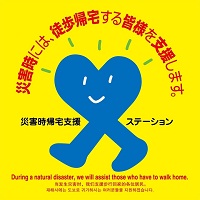
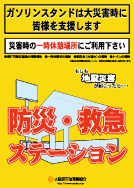
(2) Daily preparations
Prepare for disasters.
To minimize damage from earthquakes, daily preparations are important. Think about daily safety with your family members on a regular basis.
- Secure large furniture so that it does not fall.
- Maintain a survival kit in a bag so that you can retrieve it immediately.
- Prepare food and potable water for three to seven days.
- Check where the nearest emergency center is.
- Determine where your family members meet and how your family members get in touch with each other.
By registering your mobile phone email address with “Bosai Information Mail,” you can receive information on disaster prevention.
By registering your mobile phone e-mail address through the “Disaster Prevention Information Email,” you can receive information on weather, earthquakes, tsunami, and other disasters by e-mail (in 14 languages including Japanese).
Send a blank e-mail to touroku@osaka-bousai.net to subscribe or unsubscribe, and you will receive a confirmation e-mail.
Earthquake・Tsunami
Earthquakes occur frequently in Japan. Please prepare for earthquakes before one occurs.
1 In the Event of an Earthquake
When an earthquake occurs
(When you are at home)
- (Remain calm)
- It is not possible to immediately judge what has happened. Even if the shaking lasts only a few seconds, it may feel like a very long time. Remain calm and don’t panic.
- (Cover your body)
- First, protect your body. Take cover under something sturdy so that you will not become trapped under furniture or the ceiling.
- (When you are sleeping)
- Cover your head with a futon or pillows and go under a bed, etc. to protect yourself from falling furniture.. Pay attention to changes in the room caused by the earthquake.
- (When you are cooking)
- Take cover under a solid piece of furniture such as a desk. After the shaking has subsided, quickly turn off things such as the stove or iron, and close the main gas valve. Gas miconmeters, which automatically shut off the gas supply when they sense strong shaking, are increasingly being installed, but there is a risk of fire spreading so be sure to keep a fire extinguisher ready.
- (Stay away from fires)
- Municipal gas will be automatically shut off when there is an earthquake equivalent to intensity 5 or stronger. Don’t try too hard to extinguish fires, and stay away from them until the shaking has subsided.
- (When you are taking a bath or in a restroom)
- Don’t dash out of the room. Open a door or window to secure an exit. If you are taking a bath, deal with fires after the shaking has subsided.
(When you are outside)
- (When you are driving)
- Avoid sudden braking. Hold the steering wheel firmly, and bring the vehicle to a stop on the left side of the road by using the safest method possible, such as gradually slowing down. If you are forced to leave your vehicle on the road and evacuate, turn off the engine, leave the key in the ignition, close the windows, and leave the doors unlocked. You should also write a memo with your name and telephone number and place it inside the windshield, and don’t forget to take valuables such as the vehicle inspection certificate with you.
*Even if you’re driving on an expressway, take your time to slow down and stop your vehicle on the shoulder. There are emergency exits at an interval of about 1 kilometer, so pay attention to your surroundings and evacuate. - (When you are on a bus)
- Grab the seat in front of you and hang on to a strap, or squat down to grab a leg of a seat. Even after the shaking has subsided, do not hurry to get off. Please follow the driver’s instructions.
- (When you are on a train)
- Hold onto a strap or handle firmly with both hands. If you are sitting on a seat, lean forward and protect your head with a magazine or a bag, etc. Do not rush to get off the train. Follow the instructions or the train crew. In the case of the subway, high-power electric currents run next to the rail, and there is a danger of electric shock.
- (When you are in an elevator)
- Some elevators may automatically stop at the nearest floor because of earthquake sensors. Press the buttons for all floors and get off as soon as the elevator stops. If you are trapped inside, remain calm even if it is pitch-dark due to a power outage, and wait to be rescued.
- (When you are in a department store or a supermarket)
- If you feel shaking, protect your head with something such as a bag and stay away from things such as showcase windows and products. Stay close to a pillar or a wall and follow the instructions of store staff. It is dangerous to panic and rush toward the exit.
- (When you are in underground shopping area)
- Stay close to a large pillar or wall and wait for the shaking to subside. There are exits at intervals of approximately 60 meters. Even if there is a power outage, guidance lights will turn on, so remain calm and follow the instructions that are announced over the microphone. If a fire occurs, cover your nose and mouth with a handkerchief, etc., keep yourself as low as possible, and move along the wall to evacuate to above ground.
- (When you are in school)
- Follow the instructions of teachers and announcements from the school. When you are in a classroom, go under a desk and grab the desk legs.
- (When you are in workplace)
- Get away from windows, a locker or a shelf. Go under a desk to protect yourself.
- (If you’re in a business district)
- Buildings’ windows could break, sending glass falling to the street below. Move to a safe location.
- (When you are on a bridge)
- If you are on a bridge or a pedestrian bridge, hold firmly onto a handle or fence so that you will not be thrown off by the shaking. When the shaking has subsided, immediately move away from that place.
- (When you are in a coastal or river area)
- Watch out for tsunamis. Evacuate immediately to a safer place such as high ground.
Immediately after an earthquake, when the shaking has subsided
- (Turn on the radio or television.)
- Check information as soon as possible, and act calmly.
- (Is your family okay?)
- If someone has been injured, think about taking the injured person to the hospital on your own or with the help of a nearby person.
- (Wear shoes or slippers and be careful of glass in the room.)
- Things such as broken glass inside and outside your house are dangerous. Be sure to wear slippers, etc. and never walk around barefoot.
- (Be prepared for aftershocks.)
- If you go outside, be prepared for collapsed houses and wear protective clothing.
- (Evacuation from tsunami)
- If you are in an area that is predicted to be submerged, such as near a coast or a river, evacuate as soon as possible to the third floor or higher of a reinforced concrete building such as a tsunami evacuation building.
- (In a housing complex)
- Open a door or window to secure an emergency exit. Never use an elevator for evacuation. If there is a fire, keep yourself as low as possible so that you won’t be engulfed by flames or smoke, and use the stairs to evacuate.
- (When you leave your house, post a message.)
- If you will go to an evacuation center or temporarily evacuate to a place outside the area, please post a message in front of your house that states your destination and contact information.
- (Do not evacuate by automobile.)
- In principle, please do not evacuate by automobile, because evacuation may be delayed due to traffic jams and also because it is necessary to leave roads clear for emergency vehicles to pass.
Help each other !
- Call out neighbors to confirm their safety.
- If someone is trapped under a building or furniture, save him or her with your neighbors. Be careful of a gas leak, an electric leak and an aftershock.
- Be careful of aftershocks, and share food and water with other households.
- Provide first aid for injured people. Seriously injured people should be carried to the hospital.
- Extinguish a fire using a fire extinguisher or a portable fire pump.
- Useful supplies for rescue work include shovels, rope, and crowbars. Make use of household tools as well as rescue tools, equipment, and other supplies stored at elementary and junior high schools, parks, and other locations.
- Patrol your town in turns to prevent crime
2 Protect yourself from a Tsunami
1 Evacuate quickly!
According to predictions by the Osaka Prefectural government, after a Nankai Megathrust earthquake, a tsunami over one meter high will reach Osaka City within one hour and fifty minutes.
Osaka City is preparing levees to product the city area from flood damage due to tsunami, etc. However, in light of lessons learned from the Great East Japan Earthquake, if a tsunami alarm or major tsunami alarm is sounded in the Osaka City area please evacuate promptly.
2 Characteristic of a Tsunami
- (Fast and powerful)
- In coastal areas, a tsunami travels at the speed of a sprinter. A small wave (ankle height) is powerful enough to prevent you from standing.
- (Tsunami goes upstream on rivers.)
- Tsunami goes upstream on rivers. It is necessary to be cautious of tsunami not only in coastal areas, but also in river basins.
- (Tsunami is repeatedly produced)
- Tsunami will strike repeatedly. Stay in a high place for evacuation until the warning or advisory is cancelled.
- (Breakwater may not be produced)
- Before a Tsunami occurs, a Tsunami breakwater can be seen. But a Tsunami may attack without any indication.
3 How to protect yourself from Tsunami
In order to protect yourself from a tsunami, escape as quickly and to as high a place as possible.
- (Don’t act on your own judgment based on the amount of shaking by the earthquake.)
Even if there is little shaking, there is a possibility of tsunami. Even if there is little shaking, evacuate first. - (Do not use an automobile to evacuate.)
In principle, do not use an automobile to evacuate. It is possible that evacuation will be delayed due to traffic jams. - (Escape as quickly and to as high a place as possible.)
In order to protect yourself from tsunami, escape as quickly and to as high a place as possible. If flooding has already begun, every minute counts. Evacuate to a high place rather than a place far away. Try to escape to the 3rd floor or higher of a nearby apartment building or other building.
Tsunami evacuation facilities
Osaka City is working to secure tsunami evacuation facilities where residents can immediately temporarily evacuate or take shelter from a tsunami. The areas subject to this effort, based on the Osaka Prefecture's tsunami flooding predictions, are Nishiyodogawa, Konohana, Minato, Taisho, Nishinari, Suminoe, Yodogawa, Fukushima, Nishi, Naniwa, Kita, Miyakojima, Chuo, Asahi, Joto, Tsurumi, and Sumiyoshi wards. In addition to those areas, the City is securing evacuation facilities in five other wards in the eastern part of Osaka (Higashiyodogawa, Higashinari, Ikuno, Higashisumiyoshi, and Hirano wards) where no tsunami flooding is expected, but where river flooding could happen.
*Tsunami shelters are known as “Tsunami Evacuation Bldg.” in Fukushima Ward, Konohana Ward, Nishi Ward, Minato Ward, Taisho Ward, Naniwa Ward, Nishiyodogawa Ward, Yodogawa Ward, Suminoe Ward, Nishinari Ward, Kita Ward, and Miyakojima Ward, but as “Flood Disaster Evacuation Bldg.” in Chuo Ward, Asahi Ward, Joto Ward, Tsurumi Ward, Sumiyoshi Ward, Higashiyodogawa Ward, Higashinari Ward, Ikuno Ward, Higashisumiyoshi Ward, and Hirano Ward.
https://www.city.osaka.lg.jp/kikikanrishitsu/page/0000138173.html
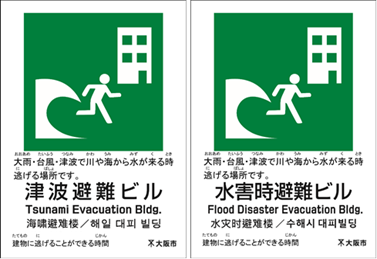
Typhoon
1 Typhoon and heavy rain bring massive disasters
In Japan, most typhoons approach or come ashore between July and October, and they cause strong winds and heavy rain over a wide area for many hours. In addition, when a typhoon approaches and atmospheric pressure is low, the ocean surface rises. Strong winds also blow seawater onto the shore, the ocean surface becomes high, and tidal waves occur.
In recent years, flood damage has also been occurring frequently due to "guerilla rainstorms" or torrential rains, and linear rainbands.
"Guerilla rainstorms" are sudden, unexpected cloudbursts that occur when cumulonimbus clouds develop rapidly in a limited area, whereas in linear rainbands, cumulonimbus clouds form consecutively in the same area for an extended period of time, causing torrential rains.
Characteristic of flood damage in urban area
Since many portions of Osaka City are paved with asphalt, a huge amount of rainwater can flow into the sewers at once, and drains’ capacity for handling the water will be exceeded. Eventually rainwater will come out from manholes and side ditches. Flooding can result in great damage to underground areas and basements.
If you are underground, do not assume that you are safe. Pay attention to how much and how long it has been raining, and try to ascertain what is happening outside. The force of water flowing down stairs can be so strong that it can be difficult to evacuate to the ground level. If flooding is expected, evacuate from underground as soon as possible.
2 Preparations for Typhoon and heavy rain
Prepare yourself before a disaster occurs.
- Use a flood hazard map to ascertain the degree of flooding that is possible in the place where you live.
https://www.city.osaka.lg.jp/kikikanrishitsu/page/0000299877.html - Find out which places are dangerous, such as those that are lower than their surroundings.
- Confirm evacuation places and evacuation routes.
- Check places around your home to see whether trash and leaves have accumulated in street gutters or drain ditches.
- If you live in an area that has a risk of being flooded or on low land, prepare sandbags, etc.
Pay attention to weather information.
Check your television, radio, telephone (177), or the internet to get updated information such as warnings and advisories from the Japan Meteorological Agency.
Do not go outside unless it is necessary.
Do not go outside when a typhoon is approaching or when there is a downpour. When it is necessary to go outside, check the weather information and stay away from places that seem even a bit dangerous. In particular, accidents often occur when people go to look at levees, beaches, or rivers.
In case of strong winds
- (When you are outside on a street)
- Watch out for falling roof tiles, signs, street trees, etc. Do not force yourself to walk. Evacuate into a nearby sturdy building.
- (When you are inside)
- Strong winds and flying objects may break windows, and there is a danger of flying pieces of glass. Do not get close to the windows during strong winds.
- (When you are on seashore)
- You may fall into the sea or be caught in a high wave. There is also the risk of a storm surge, so leave the seashore area immediately.
In case of heavy rain
- (When you are near a river)
- There is a danger of rivers suddenly swelling due to an upstream downpour. Keep away from rivers, etc. If there is evacuation information, quickly evacuate to the 3rd floor or higher of a building. When there are strong winds or a downpour, please take sufficient care because it is sometimes difficult to hear evacuation information from disaster-prevention speakers.
- (When you are on the street)
- If the road starts to become flooded, evacuate to the 3rd floor or higher of a nearby building. When doing so, if possible use the stairs to go to upper floors. Stay away from water channels and side ditches, because there is a danger that the amount of water will increase.
- (When you are driving)
- Visibility is poor and sometimes steering or the brakes do not work well, so please refrain from driving. If you are driving, do not drive through places where the road might become flooded, such as underpasses.
3 When evacuating during the typhoon and heavy rain
Evacuation due to the risk of flooding
- If you live in a one- or two-story wooden house or on a lower floor of an apartment building, etc. that may be flooded, evacuate to a disaster evacuation area or a building that is designated a Tsunami Evacuation Building/ Flood Disaster Evacuation Building, or to a tall building nearby.
- If you live on the 3rd floor or higher of an apartment building, etc. that is not likely to be flooded:
Stay in a safe place in your home and ensure your safety.
- (Evacuate in comfortable and protective clothing)
- Protect your head with a helmet or anything that can cover your head. Wear shoes that do not slip easily. It’s dangerous to wear rain boots or go barefoot. Keep both of your hands free.
- (If a flood is occurring, evacuate to a nearby tall building.)
- Evacuation when a flood is already occurring is extremely dangerous. In a situation when it is difficult to go to an evacuation center, such as when a flood is already occurring and it is pitch-dark, temporarily evacuate to the 3rd floor or higher of a nearby building.
- (Points of caution when you must evacuate in a flood)
-
- Pay attention to the depth of water.
The approximate depth of water in which it is possible to walk is 70cm for men and 50cm for women. However, even if a flood is only up to your ankle, if the current is strong you should wait for help in a high place rather than walk. - Watch your step.
Under the surface of the water there are dangerous places such as uncovered manholes and side ditches. When you walk, confirm the safety of where you are walking by using a long stick, etc. as a walking stick. - Do not evacuate alone
Call out your neighbors and evacuate with them as a group. Tie a part of your body to someone else with a rope so that you will not be separated. - For children and elderly people
Carry elderly or sick people on your back. Give an inner tube (flotation device) to children to ensure their safety.
- Pay attention to the depth of water.
Protecting yourself from lightning
When you hear thunder or see thunder clouds approaching, there is an immediate danger of lightning strike. Depending on the position of the thunder clouds, lighting can strike anywhere, including ocean surfaces, fields, and mountains. If something tall is nearby, there is a tendency for lighting to travel through it. It is more likely for people to be struck by lightning in open places such as sports fields, golf courses, outdoor pools, levees, beaches, and on the ocean, and in high places such as atop mountains and on ridges. Please evacuate to a safe space as soon as possible.The insides of reinforced concrete buildings, automobiles, buses, and trains are relatively safe spaces. The insides of wooden buildings are also basically safe, but it is safer to be at least 1 meter away from all electrical appliances, ceilings, and walls.

